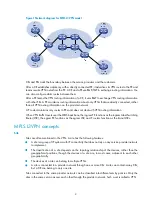
16
Step Command
Remarks
6.
Redistribute remote site routes
advertised by the PE.
import-route
protocol
[
process-id
|
all-processes
] [
med
med-value
|
route-policy
route-policy-name
] *
By default, no route redistribution
is configured.
7.
Configure a filtering policy to
filter the routes to be
advertised.
filter-policy
{
acl-number
|
ip-prefix
ip-prefix-name
}
export
[
direct
|
isis
process-id
|
ospf
process-id
|
rip
process-id
|
static
]
Optional.
By default, BGP does not filter the
routes to be advertised.
8.
Configure a filtering policy to
filter the received routes.
filter-policy
{
acl-number
|
ip-prefix
ip-prefix-name
}
import
Optional.
By default, BGP does not filter the
received routes.
NOTE:
After you configure a VPN site as an IBGP peer of the MCE, the MCE does not advertise the BGP routes
learned from the VPN site to other IBGP peers, including VPNv4 peers. Only when you configure the VPN
site as a client of the RR (the MCE), does the MCE advertise routes learned from it to other IBGP peers.
2.
Configure a VPN site:
Step Command
Remarks
1.
Enter system view.
system-view
N/A
2.
Enter BGP view.
bgp
as-number
N/A
3.
Configure the MCE as the
IBGP peer.
peer
{
group-name
|
ip-address
}
as-number
as-number
N/A
4.
Redistribute the IGP routes of
the VPN.
import-route
protocol
[
process-id
]
[
med
med-value
|
route-policy
route-policy-name
] *
Optional.
A VPN site must advertise the VPN
network addresses it can reach to
the connected MCE.
Configuring routing between MCE and PE
MCE-PE routing configuration includes these tasks:
•
Bind the MCE-PE interfaces to VPN instances
•
Perform route configurations
•
Redistribute VPN routes into the routing protocol running between the MCE and the PE.
Configuring static routing between MCE and PE
Step Command
Remarks
1.
Enter system view.
system-view
N/A















































